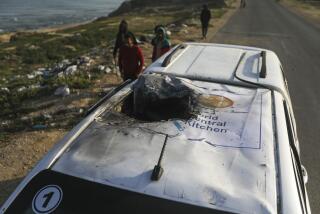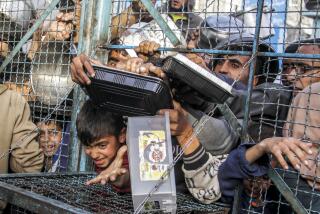Life in the Gaza Strip — a cauldron of deficit, despair and desperation

Deficit and desperation define life these days in the Gaza Strip. Residents make do with four hours of electricity a day. Most people don’t have access to clean water because the supply system is contaminated with sewage. Breakfast for some schoolchildren is a cup of hot water flavored with a dash of salt.
“Despair isn’t even the right word to describe what’s going on here because things are getting worse and worse,” said Omar Ghraieb, 31, a journalist and digital media manager living in Gaza. “We wake up to a world of struggles each day.”
For the record:
1:35 p.m. Feb. 21, 2018This article incorrectly states that the number of supply trucks entering Gaza from Israel has dropped to 300 per week. The correct number is 300 per day. It also quotes the executive director of the U.S. Campaign for Palestinian Rights as saying that fishermen in Gaza face a 3-nautical-mile limit due to Israel’s naval blockade of the territory. The fishing zone was three nautical miles in the past, but was extended to six, with temporary extensions to nine miles during sardine season.
For more than a decade Palestinians living in Gaza have endured major escalations of violence and an air and sea blockade, imposed by Israel and Egypt, that has decimated the infrastructure, stifled economic growth and made living conditions so dismal that United Nations officials say a humanitarian disaster is unavoidable.
“We really are seeing a collapse in place,” said Matthias Schmale, director of the U.N. Relief and Works Agency, or UNRWA, which provides humanitarian assistance to more than 1.3 million refugees in the self-governing Palestinian territory.
The Palestinian Authority has denied the severity of the situation, according to local media reports, blaming such news on a misinformation campaign by Hamas, the Islamic militant group that governs Gaza.
Israel’s army chief of staff, Gen. Gadi Eisenkot, acknowledged the emergency, but Defense Minister Avigdor Lieberman recently contradicted him, saying that although the economic situation was complicated and had to be tackled, there was “no humanitarian crisis.”
Both Israel and the United States charge that Hamas, which they list as a terrorist organization, is contributing to the deterioration of conditions in Gaza because the organization has prioritized spending on arms and formulating strategies to launch attacks against Israel, rather than funding social needs such as food or education.
Harrowing hardships
For most of those struggling to survive in Gaza, the hardships are real.
Speaking via the social media app WhatsApp, Ghraieb recalled how it was not so long ago that the power stayed on for eight hours each day, enough time to cook, surf the internet and heat the apartment that he shares with his father and sister.
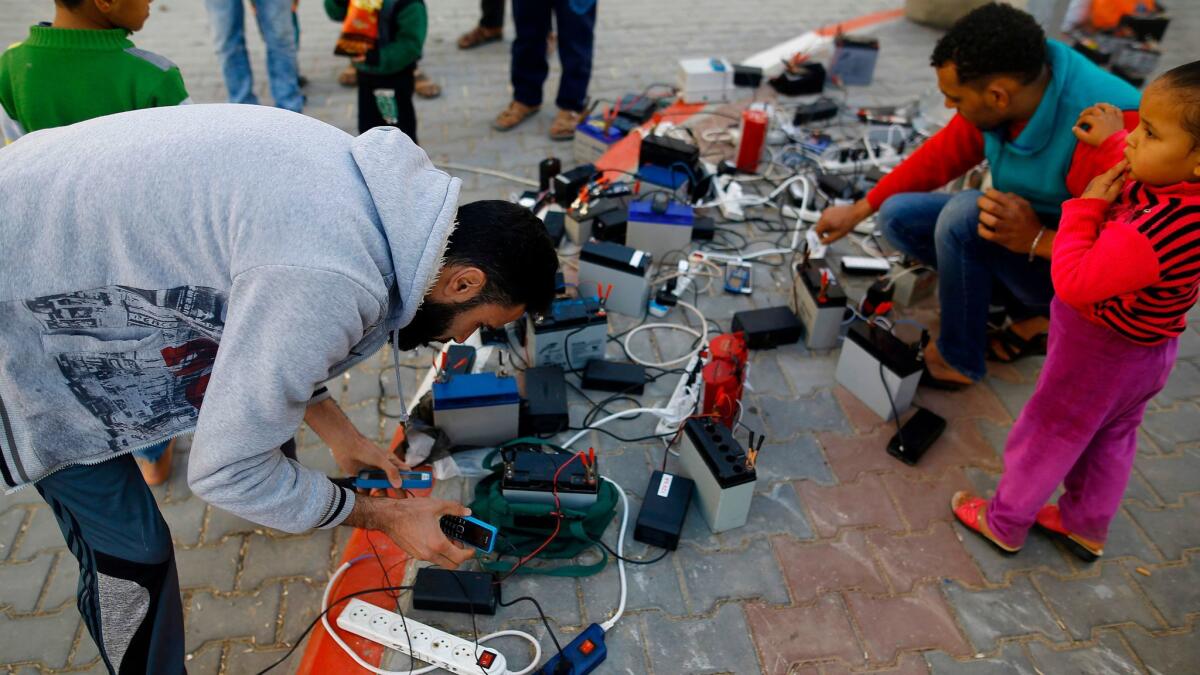
In June, as a punitive measure against Hamas, the Palestinian Authority stopped paying Israel to supply Gaza with electricity, causing the drastic restriction on power.
Many people have resorted to burning wood and stocking up on blankets to stay warm, Ghraieb said. Generators are available, but few people can afford the fuel to run them.
“Of course some have it better than others, but … it’s like we went back a decade,” Ghraieb said. “It’s crazy seeing the world advance by the minute while seeing a place you call home decline by the second.”
Health facilities are also feeling the strain of the power scarcity. Last week, a hospital serving 66,000 people in the northern Gaza Strip halted operations and a children’s medical center reduced its services to a bare minimum.
Adding to the frustration is the knowledge that the situation in Gaza was once much better, said Yousef Munayyer, executive director of the U.S. Campaign for Palestinian Rights, a nationwide coalition in the United States of more than 300 organizations working to advocate for Palestinian rights. “At one point everybody had electricity. Everybody had running water, [working] toilets … these kinds of things. It’s not that it never got to that stage of development.”
According to the World Bank, only 10% of Gaza’s population has access to safe drinking water. The sewage system has broken down and wastewater pollutes the aquifer that flows beneath Gaza.
The 1.3 million refugees whom UNRWA serves account for about 70% of Gaza’s population of 2 million people. Of these refugees, 77% live in poverty and depend on the U.N. agency for food, Schmale said.
“Gaza is a place that has been testing the limits of what the minimum level of sustainability is before a total humanitarian catastrophe,” Munayyer said. “We inch closer every day to finding where that threshold is.”
An economy in ruins
About 46% the population in Gaza, which covers 141 square miles, is without work. The statistic stands at 64% among young people under the age of 25, and at 77% for women within that group. And unemployment is rising, according to U.N. officials.
“A lot of these industries that you could rely on to produce and generate some independent dynamism for the economy have also suffered because of the siege policy,” Munayyer said.
Egypt’s border with Gaza is closed and Israel allows only trucks carrying food or other humanitarian necessities to pass through. The dramatic drop in purchasing power of Gazans is evident in the number of supply trucks entering the strip weekly from Israel. It has dropped from an average of 900 trucks a week to about 300, according to Israeli army data.
Entire industries have collapsed within the Gaza Strip. Farming areas along the perimeter of the strip have been ruined by the siege and three recent wars with Israel, in 2009, 2012 and 2014.
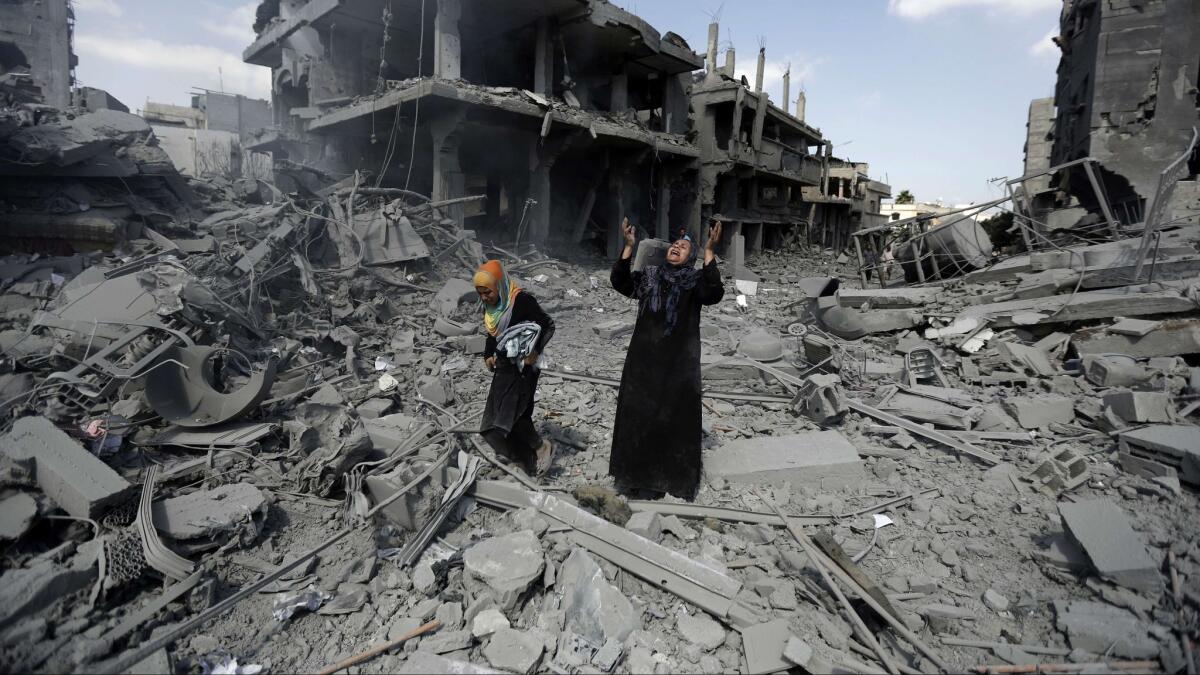
“Much of that agricultural land has been destroyed by frequent invasion of heavily armored vehicles or is off-limits to Palestinians because the Israelis enforce a buffer zone inside the Gaza Strip,” Munayyer said.
The fishing industry has been central to Gaza for hundreds of years because of the region’s proximity to the coast, but fishermen are not permitted to go beyond three nautical miles because of a naval blockade, he said.
“So now in recent years, for the first time in history, the primary source of fish in the Gaza Strip is no longer fresh cod fish, but farmed fish on land, because there’s an overfishing problem within the 3-nautical-mile limit,” Munayyer said. “Many of the species the fishermen go after is beyond that mark now.”
UNRWA remains one of Gaza’s biggest employers, providing jobs for about 13,000 people, Schmale said. They fulfill a variety of roles, including about 9,000 teachers and principals who work at the 275 schools run by the agency.
Funding cuts threaten to worsen the crisis
The assistance the U.N. agency provides is in jeopardy. In January, the Trump administration announced that it was withholding $65 million out of the $125 million of planned funding to the agency — a move that humanitarian officials said would exacerbate the crisis.
U.S. officials said that the decision had nothing to do with punishing the Palestinians for refusing to enter new peace negotiations with Israel, as many observers argue, but rather was to encourage other donors to increase their support to Gaza and push the relief organization to undertake reforms.
But two weeks before the funding cuts were announced, Trump complained via Twitter that the Palestinians “don’t even want to negotiate a long overdue peace treaty with Israel.” And as such, “why should we make any of these massive future payments to them?” he tweeted.
Critics said such sentiments bordered on holding the lives of thousands of desperate people ransom.
“This is essentially telling Palestinians that either you stop protesting or we will starve you,” said Noura Erakat, an assistant professor at the School of Integrative Studies at George Mason University.
She said it was wrong to tie humanitarian assistance to peace negotiations.
“Palestinian lives are being manipulated and played with in order to compel them to succumb to a political reality of Israeli dominance, which they refuse,” Erakat said.
Schmale said the reforms Washington wanted his agency to undertake included improving management and efficiency; changing the school curriculum and eliminating books that might have a jihadist bent and incite students to violence; and requiring the agency to stop registering Palestinian refugees.
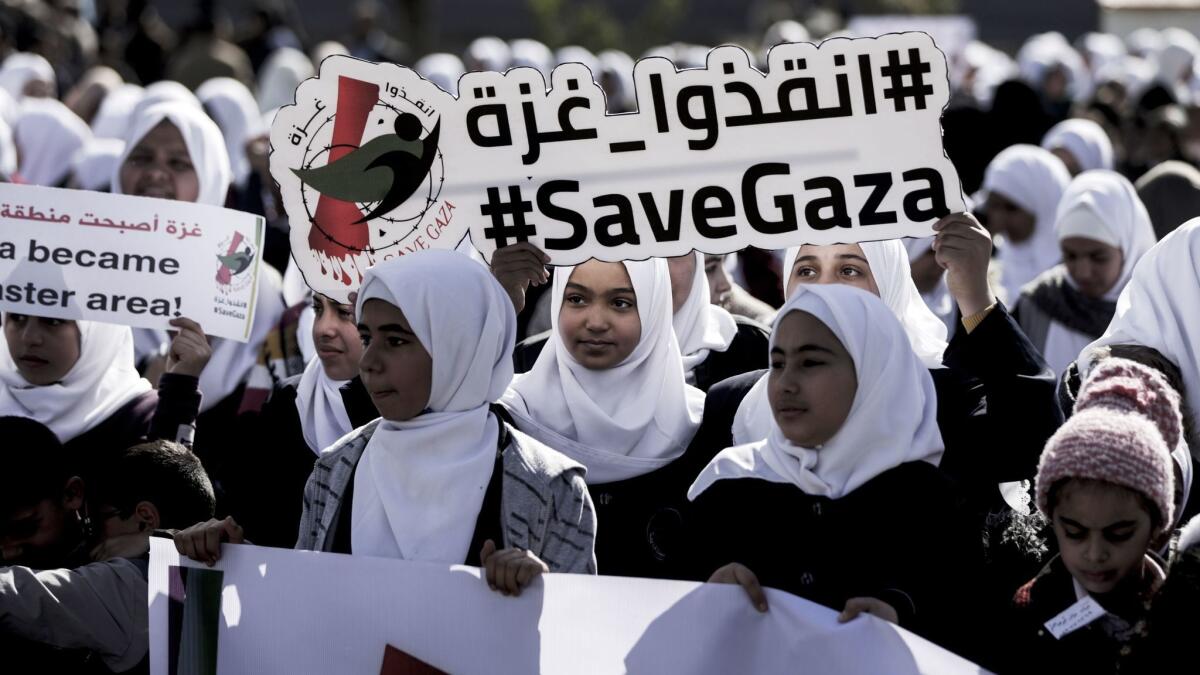
Schools would strongly feel the pinch of less aid money, because the cuts would lead to a $240-million deficit of funds for education, he said.
“I dread being forced into a situation at one point where we have to say, ‘Sorry we don’t have the money to continue your education,’ because while the food will affect people physically and plunge them into further poverty, reducing or stopping education kills hope for the future.”
U.N. officials, humanitarian workers and analysts warned that slashing funding to the relief agency not only threatened livelihoods, health and education, but also could undermine the region’s stability.
“We are a factor of stability because of the sheer volume of what we pump in here,” Schmale said. “The stopping or reducing of food distribution could just be one of the matches that lights the fire here. When you have this kind of high unemployment, desperate people without much of a horizon … stopping the food distribution could spark riots because people have very little to lose.”
Ghraieb, the journalist, acknowledged that the dearth of funding could worsen the humanitarian situation, but “we’re really past the blame game.”
“It gets to a point where you just want a chance to live life in dignity and in peace, feeling that you don’t have to wake up every day facing so many struggles,” he said.
Special correspondent Noga Tarnopolsky in Jerusalem contributed to this report.
For more on global development news, see our Global Development Watch page, and follow me @AMSimmons1 on Twitter
More to Read
Start your day right
Sign up for Essential California for news, features and recommendations from the L.A. Times and beyond in your inbox six days a week.
You may occasionally receive promotional content from the Los Angeles Times.
